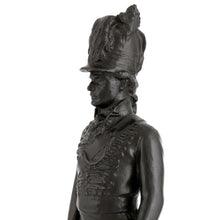Rifle Brigade - A Napoleonic Period Officer of the 95th Rifles, 1925
Adding product to your cart
Height overall: 36cm (14.2in)
Provenance: M.G Kerr
Patinated bronze. Standing figure of an officer of the 95th Rifles in the uniform of 1800, comprising Tarleton helmet, light dragoon style jacket and tight fitting pantaloons. Signed ‘J. Tweed / 1925’ to the integral bronze base, the front impressed ‘1800’ in which year the corps of riflemen was raised, the whole mounted on a square verde antico marble base applied with a silvered plaque inscribed ‘Misdirection / The Rifle Brigade Light Weight Race March 15th 1933’ Height of bronze: 28.5cm (11.2in). The 1933 Rifle Brigade Point-to-Point was held jointly with the Lamerton Hunt at Kilworthy, near Tavistock. The winner of the present trophy was one Mr. M.G. Kerr of Sir W. W. Wynn’s Hounds.
read more
The present model is known as a maquette for the First World War Rifle Brigade Memorial, London by John Tweed and was created at the behest of Colonel Willoughby Verner in 1918 when he wrote to the sculptor with his thoughts on what form the memorial should take. These included the three figures seen today on the memorial in Westminster’s Grosvenor Gardens; a Great War rifleman, one from the Crimean War and one from the Peninsula War. For the latter Tweed settled on a uniform style pre-dating the Peninsula where the shako was generally worn, with peak up, in place of the turbaned and crested Tarleton. Tweed’s source for this and for the present model was a drawing of 1804 by Captain A.D. Cameron, who, in 1800, recruited 200 Highlanders to form a highland company in the new Experimental Corps of Riflemen (95th Rifles), and later proved himself the most undaunted of Riflemen when in command of the rearguard during the Retreat to Corunna.

Tweed was a highly regarded in the execution of war memorials, with several notable examples to his name, including the King’s Royal Rifle Corps Memorial, Winchester of which reduced scale bronze figures were also cast. Moreover Tweed’s daughters presented the Royal Green Jackets with an identical bronze to the present figure for the regimental collection.
John Tweed (1869-1933) numbered amongst the leading sculptors of his generation and is remembered for his long and close friendship with Auguste Rodin (1840-1917). He did much to make the diffident and awkward genius feel at ease in London society before the First World War. Rodin frequently stayed at the Tweed family home in Cheyne Walk, and in 1902 he put a cottage and studio at Tweed's disposal at his residence at Meudon on the outskirts of Paris. Tweed also did much to promote and popularize Rodin in Britain. This culminated in an exhibition of sculpture at Grosvenor House, London, in 1914, which Rodin subsequently gifted to the nation to symbolize the comradeship of France and Britain.
Tweed was the son of a Glasgow publisher. His father’s death necessitated his leaving school to run the family business. He studied part time at the Glasgow School of Art, and later in London under Hamo Thornycroft, who insisted he continued his formal training at the Technical Art School, Lambeth, and the Royal Academy Schools. In 1893 Tweed moved to Paris with the hope of studying with Rodin, but this proved impossible as Rodin would only accept pupils who would spend four years under his tutelage. Instead Tweed briefly studied at the École des Beaux-Arts before returning to London to execute a bronze relief for Cecil Rhodes’ residence, Groote Schuur in Cape Town.
In 1895 Tweed married Edith Clinton, who was secretary to the Women's Suffrage Society, and set up home at 108 Cheyne Walk in Chelsea. In 1901 he was commissioned to complete the equestrian group surmounting the Wellington monument in St Paul's Cathedral, London. Tweed’s appointment provoked debate, as he was then little known and was considered suspiciously modern. The monument was eventually completed in 1912, with Tweed's reputation enhanced.
Besides Rhodes and Rodin, Tweed was on familiar terms with Edwin Lutyens, John Singer Sargent, Hilaire Belloc, and Ramsay MacDonald. As sculptor of public monuments, Tweed was both prolific and successful. In addition to the war memorials to the King's Royal Rifle Corps at Winchester, and the Rifle Brigade in Grosvenor Place, London (1924) these include the lively and realistic portrait statues of Lord Clive in King Charles Street, Whitehall (1917) and Lord Kitchener, Horse Guards Parade (1926). Other notable commissions were monuments to Joseph Chamberlain in Westminster Abbey (1915) and Field Marshal Earl Roberts (1926) in St Paul's, Captain Cook at Whitby, Yorkshire, a marble bust of Lord Curzon of Kedleston for the Oxford Union; a statue of Sir John Moore at Shorncliffe; the equestrian statue of Sir George White, in Portland Place, and the House of Lords War Memorial comprising a figure of a youth returning a sword to a figure representing the Motherland.










